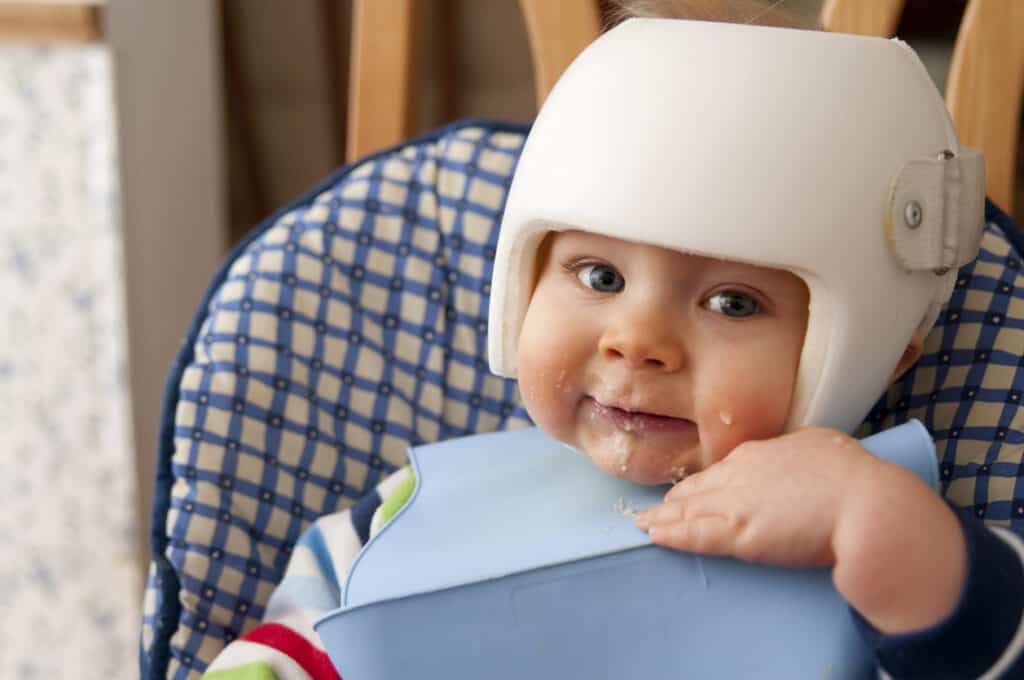Baby tilting head to shoulder is a common behavior among infants that can be concerning for parents or caregivers. While it may seem unusual or even alarming, it is often a normal developmental milestone that babies go through.
Understanding the reasons behind this behavior and when to seek professional help can help ease parents’ worries and ensure that their baby is healthy and developing normally.
There are several reasons why a baby may tilt their head to one side or shoulder. One common reason is that they are simply exploring their environment and testing the range of motion in their neck muscles. In some cases, it may be a sign of an underlying medical condition, such as torticollis or plagiocephaly.
Understanding the causes and symptoms of these conditions can help parents identify when to seek professional help and treatment for their baby.
Key Takeaways
- Baby head tilting is a common behavior among infants that can be a normal part of development.
- Understanding the causes and symptoms of medical conditions such as torticollis or plagiocephaly can help parents identify when to seek professional help.
- Regular check-ups with a pediatrician can help ensure that a baby is developing normally and address any concerns parents may have about their baby’s behavior.
Understanding Baby Head Tilting
When a baby tilts their head to the side, it can be a cause for concern for many parents. However, in most cases, it is a normal part of development and nothing to worry about.
Here’s what you need to know about baby head tilting:
1. What is Baby Head Tilting?
Baby head tilting is when a baby tilts their head to one side or the other, often with their ear nearly touching their shoulder. It can happen while the baby is lying down, sitting up, or even standing. Some babies might do this occasionally, while others do it more frequently.
2. Why Do Babies Tilt Their Heads?
There are several reasons why babies tilt their heads, including:
- Muscle Development: Tilting the head helps to strengthen the neck muscles, which are essential for holding up the head and sitting up.
- Visual Stimulation: Babies might tilt their head to get a better view of something or to focus on a particular object.
- Ear Infection: In some cases, head tilting can be a sign of an ear infection, as the baby might be trying to alleviate ear pain or pressure.
3. When Should You Be Concerned?
While head tilting is generally harmless, there are a few situations where you should talk to your pediatrician:
- If the head tilting is accompanied by other symptoms, such as fever or vomiting.
- If the head tilting is only to one side and the baby seems to have difficulty moving their head in the opposite direction.
- If the head tilting persists beyond six months of age.
Overall, baby head tilting is a normal part of development and nothing to worry about in most cases. However, if you have any concerns, it’s always best to talk to your pediatrician.
Causes of Baby Head Tilting
When a baby tilts their head to one side, it can be concerning for parents. There are several possible reasons why a baby may tilt their head to one side, including:
1. Congenital Muscular Torticollis
Congenital muscular torticollis is a condition that occurs when a baby’s neck muscle is shortened or tightened, causing the head to tilt to one side. This condition is typically present at birth and may be due to the baby’s position in the womb or a problem with the muscle itself.
2. Acquired Torticollis
Acquired torticollis is a condition that can develop after birth and may be caused by an injury or inflammation of the neck muscles. This condition can also be caused by an infection or other underlying medical condition.
3. Klippel-Feil Syndrome
Klippel-Feil Syndrome is a rare genetic disorder that affects the development of the spine. This condition can cause abnormal positioning of the head and neck, leading to a tilted head.
4. Ear Infections
Ear infections can cause pain and discomfort, which can lead to a baby tilting their head to one side. This is more common in younger children who may not be able to communicate their symptoms effectively.
5. Teething Problems
Teething can also cause discomfort and pain, which can lead to a baby tilting their head to one side. This is more common in older children who are teething.
6. Neck Trauma
Neck trauma, such as a fall or accident, can cause swelling or injury to the neck muscles, leading to a tilted head.
7. Eye Injury
An injury to the eye can cause pain and discomfort, which can lead to a baby tilting their head to one side.
8. Inherited Nervous Problem
Some babies may have an inherited nervous problem that affects the muscles in their neck, leading to a tilted head.
9. Reflux
Reflux can cause discomfort and pain, which can lead to a baby tilting their head to one side.
It is important to note that these are not the only possible causes of baby head tilting. If a baby is consistently tilting their head to one side, it is important to consult with a pediatrician, neurologist or orthopedist to determine the underlying cause and appropriate treatment.
Diagnosis of Baby Head Tilting
When a parent notices their baby tilting their head to one side, it can be concerning. There are various reasons why a baby may tilt their head to one side, and it is essential to determine the underlying cause to ensure proper treatment.
Here are the common methods of diagnosing baby head tilting:
1. Pediatrician Consultation
The first step in diagnosing baby head tilting is to consult with a pediatrician. The pediatrician will examine the baby and ask questions about the symptoms and medical history. They may also perform a physical examination to check for any underlying medical conditions that may be causing the head tilting.
The pediatrician may refer the baby to a pediatric neurologist for further evaluation.
2. X-Ray Imaging
X-ray imaging may be used to diagnose baby head tilting. X-rays can help identify any structural abnormalities in the neck or spine that may be causing the head tilting. X-rays are usually taken while the baby is in different positions, such as lying down or sitting up, to get a better view of the neck and spine.
3. Ultrasound Imaging
Ultrasound imaging may also be used to diagnose baby head tilting. Ultrasound can help identify any abnormalities in the muscles or soft tissues of the neck that may be causing the head tilting.
Ultrasound is a non-invasive imaging technique that uses sound waves to produce images of the inside of the body.
In conclusion, diagnosing baby head tilting requires a thorough evaluation by a pediatrician or pediatric neurologist. X-ray and ultrasound imaging may also be used to identify any underlying medical conditions.
It is essential to determine the underlying cause of head tilting to ensure proper treatment and prevent any potential complications.
Treatment and Management
1. Physical Therapy
Physical therapy can be an effective treatment for babies who tilt their head to one side. A physical therapist can help identify the underlying cause of the baby’s condition and develop an exercise program to address it.
The therapist may also use techniques such as massage, heat, and ultrasound to alleviate pain and discomfort.
2. Stretching Exercises
Stretching exercises can help improve the baby’s range of motion and reduce muscle tension. The baby’s caregiver or physical therapist may perform these exercises several times a day.
Some stretching exercises may include gently rotating the baby’s head to the opposite side, tummy time, and gentle neck stretches.
3. Medication and Antibiotics
In some cases, medication or antibiotics may be prescribed to treat underlying conditions that are causing the baby to tilt their head. It is important to follow the doctor’s instructions carefully and complete the full course of treatment.
4. Surgery
In rare cases, surgery may be necessary to correct the baby’s condition. This may be recommended if the baby’s condition is severe or if other treatments have not been successful.
The decision to undergo surgery should be made in consultation with the baby’s doctor and parents.
Overall, it is important to seek advice from a healthcare professional if a baby is tilting their head to one side. With proper treatment and management, most babies will recover fully and be able to move their head normally.
Prevention and Home Care
Parents can take steps to prevent their baby from developing a preference for tilting their head to one side. Some prevention and home care measures include:
1. Tummy Time and Rest
Encouraging tummy time can help strengthen the baby’s neck muscles and prevent the development of a flat spot on the back of their head. Parents can start with short periods of tummy time several times a day and gradually increase the duration as the baby gets more comfortable.
It’s also important to give the baby plenty of opportunities to rest and change positions throughout the day to avoid prolonged pressure on one area.
2. Massage and Heat Application
Gentle massage of the baby’s neck muscles can help relieve tension and discomfort. Parents can also apply a warm compress or use a heating pad on a low setting to help relax the muscles.
It’s important to be cautious when applying heat and to avoid placing anything too hot directly on the baby’s skin.
3. Sleeping Position Adjustment
Parents can try different sleeping positions and surfaces to help encourage the baby to turn their head in different directions. For example, placing the baby’s head at the foot of the crib or using a rolled-up towel or blanket under the baby’s shoulder can help encourage them to turn their head to the opposite side.
It’s important to follow safe sleep guidelines and to avoid placing any objects in the crib that could pose a suffocation hazard.
By following these prevention and home care measures, parents can help promote healthy neck development and prevent the development of a preference for tilting the head to one side.
Long-Term Effects and Complications
1. Plagiocephaly
Plagiocephaly is a condition where the baby’s head becomes flattened or twisted due to prolonged pressure on one side of the head. It can occur when a baby spends too much time lying on their back or in one position.
While plagiocephaly is not a serious condition, it can cause cosmetic concerns for some parents. In severe cases, it may also cause developmental delays or problems with vision or hearing.
To prevent plagiocephaly, parents should encourage their baby to change positions frequently throughout the day. Tummy time is also important for strengthening the neck muscles and preventing flat spots on the head.
2. Misalignment of the Eyes
When a baby tilts their head to one side for an extended period, it can cause misalignment of the eyes. This is because the muscles in the eyes become used to looking in one direction, which can cause one eye to turn inwards or outwards. If left untreated, misalignment of the eyes can lead to amblyopia, or lazy eye.
To prevent misalignment of the eyes, parents should encourage their baby to look in different directions and change positions frequently throughout the day. If misalignment is detected, it can usually be treated with glasses, eye patches, or surgery.
Overall, while tilting the head to one side may seem harmless, it can lead to long-term effects and complications if not addressed. Parents should be aware of the potential risks and take steps to prevent them.
Communicating with Your Child about Head Tilting
When a baby tilts their head to one side, it can be concerning for parents. However, it’s important to understand that this behavior is usually harmless and temporary. In most cases, it’s simply a sign that your baby is exploring their environment and developing their neck muscles.
If you notice your child tilting their head frequently, there are several things you can do to communicate with them about this behavior. Here are a few tips:
- Observe your child’s behavior: Take note of when your child tilts their head and how they react to different stimuli. This will help you understand if there is a specific trigger for the behavior.
- Talk to your child’s pediatrician: If you’re concerned about your child’s head tilting, talk to their pediatrician. They can help you determine if there is an underlying medical issue that needs to be addressed.
- Use positive reinforcement: When your child is not tilting their head, praise them for their good behavior. This will help reinforce the behavior you want to see.
- Engage your child: Play with your child and encourage them to move their head in different directions. This will help them develop their neck muscles and may reduce the frequency of head tilting.
Remember, head tilting is usually a temporary behavior that will resolve on its own as your child grows and develops. By communicating with your child and observing their behavior, you can help them develop healthy habits and reduce any concerns you may have.
When to Seek Professional Help
If a baby is tilting their head to one side consistently or for prolonged periods, it may be a cause for concern. While it is common for babies to tilt their head occasionally, consistent tilting may indicate an underlying issue.
Here are some signs that may indicate the need for professional help:
1. Sudden Change in Behavior
If a baby suddenly starts tilting their head to one side, it may be a sign of an underlying problem. This could be due to an injury, infection, or other medical condition. It is important to seek medical attention if there is a sudden change in behavior.
2. Fever
If a baby has a fever along with tilting their head, it may be a sign of an infection. It is important to monitor the baby’s temperature and seek medical attention if the fever persists or worsens.
3. Newborn Babies
Newborn babies are prone to tilting their heads to one side due to their undeveloped neck muscles. However, if the tilting persists beyond the first few months, it may be a cause for concern. It is important to seek professional help if the tilting continues.
In conclusion, if a baby is consistently tilting their head to one side, it may be a sign of an underlying problem. It is important to seek professional help if there are any sudden changes in behavior, fever, or if the tilting persists beyond the first few months.
Frequently Asked Questions
Why does my baby keep tilting his head to his shoulder?
Babies may tilt their heads to their shoulders for various reasons. One of the most common reasons is that they are trying to get a better view of something. It may also be a sign of an ear infection, torticollis, or a muscle weakness. If you are concerned about your baby’s head tilting, it is best to consult with your pediatrician.
Do babies tilt their heads when teething?
Some babies may tilt their heads when teething due to the discomfort they are experiencing. They may also be trying to relieve pressure in their jaw or ears. However, not all babies will exhibit this behavior when teething.
Why does my baby tilt her head to her side when looking at things?
Babies may tilt their heads to one side when looking at things because it helps them focus better on an object. It may also be a sign of a vision problem or muscle weakness, so it is important to monitor your baby’s behavior and consult with your pediatrician if you are concerned.
Why is my 6 month old head tilting?
A 6-month-old baby may tilt their head due to a muscle weakness or torticollis. It may also be a sign of an ear infection or a vision problem. If you are concerned about your baby’s head tilting, it is best to consult with your pediatrician.
What could be causing my baby to tilt their head to one side when walking?
If your baby is tilting their head to one side when walking, it may be a sign of a balance or coordination problem. It is important to monitor your baby’s behavior and consult with your pediatrician if you are concerned.
Is it normal for a baby to tilt their head to one side occasionally?
It is normal for babies to tilt their heads to one side occasionally, especially when they are focusing on something or trying to get a better view. However, if you notice your baby tilting their head frequently or for extended periods of time, it is best to consult with your pediatrician.

Iesha is a loving mother of 2 beautiful children. She’s an active parent who enjoys indoor and outdoor adventures with her family. Her mission is to share practical and realistic parenting advice to help the parenting community becoming stronger.



